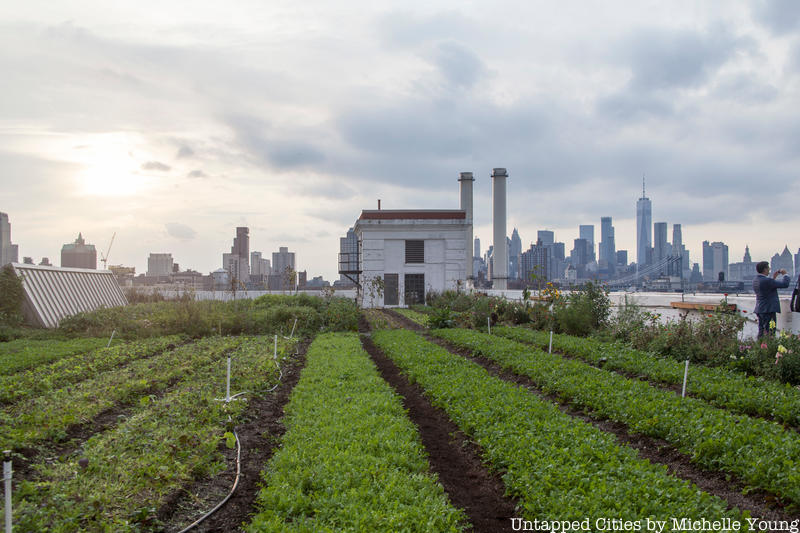
If you’re looking to expand your agricultural horizons, you might want to start looking up. Rooftop farms are more than simply a creative solution to local farming in otherwise inhospitable environments, they have become the cornerstone of an increasingly prominent wave of urban agriculture. With ground space a premium in North America’s densest metropolis, New York has positioned itself as a ripe hotbed for the implementation of such developments. Below, we showcase seven of the more notable institutions in the area, with several more to develop in the years to come.
1. Brooklyn Grange
Leading the pack in terms of acreage (2.5) and gross production (50,000 pounds of vegetables per year), the Brooklyn Grange operates a network of rooftops farms, their first opening in Long Island City in 2010. Founded through a CSA, this for-profit organization specializes in selling to local businesses and spurring community economic growth. Their Brooklyn Navy Yard location has begun offering increased public access, with school programs, sunrise yoga, and even weddings that they personally cater. They also operate the city’s largest apiary, with 30 beehives currently in operation.
2. Eagle Street Farm
Founded in 2009 by the current president of the Brooklyn Grange, Eagle Street Farm is the city’s oldest rooftop agribusiness. Located in Greenpoint atop a warehouse owned by Broadway Stages, this joint venture between farmers and theater folk is as unique as it is beneficial to this tight-knit community. The farm offers a wide variety of seasonal produce–even tobacco–and opens up a market to the public on weekends. Its contributions go beyond providing fresh food–the superstructure can offset up to 38mm of rain from the city’s aging sewer system.
3. Hell’s Kitchen Farm Project
Brooklyn jumpstarted as the epicenter of urban agriculture, but Manhattan quickly caught on to the trend with Hell’s Kitchen Farm Project. Operating where the Theater District‘s LEDs don’t shine, the farm sought refuge atop a church on Ninth Avenue across from the Port Authority Bus Terminal. HKFP’s roughly sixty volunteers manage micro gardens in the basins of kiddie pools, which provide a lightweight, durable, and affordable solution to growing in an area that suffers from a range of environmental challenges–including pigeons.
4. Riverpark Farm
On the opposite sides of Manhattan and the urban farming spectrum is Riverpark Farm, a 15,000 square foot collaboration between the Alexandria Center For Life Sciences and the adjacent Riverpark restaurant. The farm embraced its predecessors’ creative reuse of space by building on the site of the Alexandria Center, the construction of which had been temporarily stalled during the Global Financial Crisis in 2008. The farm relocated 7,000 milk crates of produce in under 24 hours once construction resumed, and it has since provided Riverpark restaurant with fresh and organic food under the direction of head chef and partner Sisha Ortúzar since 2012.
5. Gotham Greens
Rivaling Brooklyn Grange in scale and production is Gotham Greens, a designer, creator, and operator of commercial greenhouses in NYC and abroad. Currently operating facilities in Greenpoint and Gowanus, Gotham Greens is preparing to open its largest facility (60,000 square feet) in Jamaica. The organization has partnered with Whole Foods, and its Gowanus location sits atop one of its supermarkets. Distinguishing itself as a year-round distributor, Gotham Greens produces over 100 tons of produce annually. Not tethered exclusively to NYC, Gotham Greens has set its sights on partnering with real estate developers, architects, and retailers around the world.
6. Bell Book and Candle Restaurant Rooftop Garden
This West Village nook provides a similar model to Riverpark Farm, but does so through the use of aeroponics–plant cultivation with air instead of soil. Bell Book and Candle utilizes a tower garden that allows the restaurant to grow its vegetables vertically, thereby minimizing its footprint and maintaining the restaurant’s commitment to sustainable growth.
7. BrightFarms
Sunset Park is all the rage right now, years after urban design students were studying the neighborhood. In 2012, BrightFarms announced it was going to build the world’s largest rooftop farm in the US (possibly the world) on top of a 100,000 square foot former Navy building in Sunset Park. It was supposed to open in early 2014, but there hasn’t been much news the first announcement. The BrightFarms website continues to state that they are “in the process of evaluating several potential sites in New York City on which to build a state-of-the-art hydroponic greenhouse.”\8. JetBlue Farm at JFK
JetBlue just moved up in our ranks after they announced that they have a full function urban farm at the John F. Kennedy Airport. Stationed just outside Terminal 5, the farm is 24,000 square feet of concrete. According to the Modern Farmer, given that there’s no natural soil, they rely on 2,300 black plastic milk cartons bolted together to create plant beds. Moreover, Terminal 5 restaurants donate their food waste to create the soil. The farm produces mainly potatoes and a variety of herbs and vegetables.
Other Farms
The urban agriculture business has its roots in ground operations as well, and several collectives, cooperatives, and community gardens provide a critical supply of local food that predates the rooftop movement. From Randall’s Island Urban Farm on the eponymous island, La Finca del Sur in the South Bronx, and Battery Urban Farm in Lower Manhattan, these sites vary in size and scope. All contribute invaluably to their local neighborhoods through educational programs, community outreach, and sustainability measures.
Not a farmer, but still interested in contributing to communal agriculture? Read about Farmigo here, and get in touch with the author on his website and @thisisnotreale.





